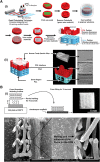Concise Review: Periodontal Tissue Regeneration Using Stem Cells: Strategies and Translational Considerations
- PMID: 30585445
- PMCID: PMC6431686
- DOI: 10.1002/sctm.18-0181
Concise Review: Periodontal Tissue Regeneration Using Stem Cells: Strategies and Translational Considerations
Abstract
Periodontitis is a widespread disease characterized by inflammation-induced progressive damage to the tooth-supporting structures until tooth loss occurs. The regeneration of lost/damaged support tissue in the periodontium, including the alveolar bone, periodontal ligament, and cementum, is an ambitious purpose of periodontal regenerative therapy and might effectively reduce periodontitis-caused tooth loss. The use of stem cells for periodontal regeneration is a hot field in translational research and an emerging potential treatment for periodontitis. This concise review summarizes the regenerative approaches using either culture-expanded or host-mobilized stem cells that are currently being investigated in the laboratory and with preclinical models for periodontal tissue regeneration and highlights the most recent evidence supporting their translational potential toward a widespread use in the clinic for combating highly prevalent periodontal disease. We conclude that in addition to in vitro cell-biomaterial design and transplantation, the engineering of biomaterial devices to encourage the innate regenerative capabilities of the periodontium warrants further investigation. In comparison to cell-based therapies, the use of biomaterials is comparatively simple and sufficiently reliable to support high levels of endogenous tissue regeneration. Thus, endogenous regenerative technology is a more economical and effective as well as safer method for the treatment of clinical patients. Stem Cells Translational Medicine 2019;8:392-403.
Keywords: Biomaterials; Cell homing; Cell transplantation; Endogenous regeneration; Periodontal regeneration; Tissue engineering.
© 2018 The Authors Stem Cells Translational Medicine published by Wiley Periodicals, Inc. on behalf of AlphaMed Press.
Conflict of interest statement
The authors indicated no potential conflicts of interest.
Figures






References
-
- Pihlstrom BL, Michalowicz BS, Johnson NW. Periodontal diseases. Lancet 2005;366:1809–1820. - PubMed
-
- Carasol M, Llodra JC, Fernández‐Meseguer A et al. Periodontal conditions among employed adults in Spain. J Clin Periodontol 2016;43:548–556. - PubMed
-
- Dye BA. Global periodontal disease epidemiology. Periodontology 2000 2012;58:10–25. - PubMed
-
- Darveau RP. Periodontitis: A polymicrobial disruption of host homeostasis. Nat Rev Microbiol 2010;8:481–490. - PubMed
Publication types
MeSH terms
Substances
LinkOut - more resources
Full Text Sources
Other Literature Sources
Medical

